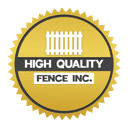A Guide to Choosing the Ideal Fence Gate for Your Home
Fence gates are more than just functional entry points; they are a gateway to your home’s personality and security. Choosing the ideal fence gate involves carefully considering materials, styles, and practical aspects. In this comprehensive guide, we navigate the diverse options available, offering insights into the world of fence gates. Whether you prioritize aesthetics, durability, or both, this guide will empower you to make informed decisions and find the perfect gate to complement your home. Explore the realm of fence gates with us as we delve into critical considerations for a tailored choice.

Types of Fence Gates
Fence gates come in various types, each offering distinct features to cater to different needs and preferences. Understanding the characteristics of these gate types is essential for making an informed decision. Here’s an overview:
- Wooden Fence Gates: Wooden gates are a classic choice, providing a warm and natural aesthetic. They are versatile, available in various styles, and may be altered to fit your property’s general aesthetic. While they offer charm, it’s essential to consider their maintenance needs, as wood may require regular attention to preserve its condition.
- Metal Fence Gates: Metal gates, whether made of iron, aluminum, or steel, are known for their durability and strength. These gates provide robust security and can withstand various weather conditions. While they may require less maintenance than wood, choosing the right metal type is crucial to prevent issues like rust.
- Vinyl Fence Gates: Vinyl gates have gained popularity for their low-maintenance and long-lasting properties. They are resistant to weather elements and do not require painting or staining. Vinyl gates come in various styles, providing homeowners practicality and aesthetic appeal. It is an excellent choice for those seeking a balance between durability and aesthetics.
Choosing the Right Material
Fence gates come in various materials, each with its characteristics. Choosing the suitable material is pivotal, as it influences the gate’s appearance, durability, and maintenance requirements. Here’s a closer look at factors to consider when selecting the material for your fence gate:
- Climate and Weather Conditions: The local climate plays an important part in choosing the suitable material. Materials resistant to rot and corrosion, such as vinyl or metal, may be preferable for areas with high humidity or frequent rain. In contrast, wood may suit drier climates with less moisture exposure.
- Budget Constraints: Your budget is crucial in choosing the suitable material. While wood gates may offer a traditional and aesthetically pleasing option, they can be more expensive than vinyl or metal alternatives. Consider the initial cost, as well as long-term maintenance expenses, when making your decision.
- Maintenance Requirements: Different materials have varying maintenance needs. Wooden gates often require staining or painting at regular intervals to preserve their appearance and protect against the elements. Metal gates may need anti-rust treatments, and vinyl gates require minimal maintenance. Assess your willingness and ability to invest time and effort in maintaining the gate over the years.
Gate Styles and Designs
Fence gates offer a canvas for diverse styles and designs, allowing homeowners to tailor their entrances to match their preferences and the property’s overall aesthetics. Understanding the various gate styles is crucial for harmonizing functionality with visual appeal. Here’s an exploration of gate styles and designs:
- Single vs. Double Gates: The choice between a single and double gate depends on the width of the entry point. Single gates are suitable for narrower openings, while double gates are ideal for wider driveways. Consider each option’s practicality and visual impact when deciding on the gate’s configuration.
- Decorative Elements: Gate designs often include decorative elements that enhance the overall appearance. Ornamental details, such as scrolls, finials, or patterns, may give your gate sophistication and originality. Balancing these decorative features with the gate’s functionality is vital to achieving a cohesive look.
- Balancing Functionality with Style: While aesthetics are important, ensuring that the chosen style aligns with the gate’s intended function is crucial. For instance, a driveway gate should complement the architectural style and provide secure and convenient access.
Sizing and Measurements
Determining the appropriate size for your fence gate is crucial in selecting and ensuring a seamless fit and optimal functionality. Accurate measurements are essential for a gate that enhances the property’s aesthetics and serves its practical purpose. Here’s a guide to sizing and measurements for your fence gate:
- Width Considerations: Measure the width of the gate opening accurately. For single gates, this measurement represents the total width required. For double gates, divide the opening width by two to determine the width for each gate leaf. Ensure there is enough clearance on either side for smooth operation.
- Height Measurements: The height of the gate is equally essential, affecting both aesthetics and security. Measure from the ground to the desired height of the gate, keeping in mind any decorative elements or architectural features you wish to incorporate.
- Consider Gate Swing: If your gate swings open, consider the space required to open without obstruction fully. This is particularly important for driveway gates where vehicles need adequate clearance.
- Account for Hardware: Factor in the dimensions of the gate hardware, including hinges and latches. This ensures that the gate fits within the opening and operates smoothly without interference.
- Measuring Guidelines for Installation: Follow installation guidelines provided by the manufacturer. These guidelines may include post-placement, depth, and spacing recommendations to ensure the gate is supported correctly.
Installation Process
The installation process of a fence gate is a critical phase that significantly influences its functionality and longevity. Hiring professionals for the installation ensures precision and adherence to best practices. Here’s an overview of the installation process:
- Site Preparation: Professionals will begin by preparing the site, ensuring the ground is level and free from obstructions. Proper site preparation is essential for the gate to operate smoothly and prevent issues in the future.
- Post Installation: Sturdy posts are crucial for the gate’s stability. Considering the gate’s size and weight, professionals will install posts at the appropriate depth and distance. Properly anchored posts are essential for supporting the gate and preventing sagging.
- Framework Assembly: The gate framework, including the top and bottom rails, will be assembled according to the manufacturer’s specifications. This step ensures that the gate maintains its structural integrity.
- Gate Hanging: The gate will be securely hung on the installed posts using durable hinges. The placement of hinges is critical for smooth operation and longevity. Professionals will ensure that the gate is level and plumb for optimal performance.
- Latch and Lock Installation: A secure latch and lock system is essential for security and convenience. Professionals will carefully install these components, ensuring they align correctly and function seamlessly.
- Final Adjustments: After the gate is hung and the hardware is in place, professionals will make any necessary adjustments to ensure the gate opens and closes smoothly. This may include fine-tuning the hinges and latches and checking for alignment issues.
Maintenance Tips
Maintaining your fence gate is essential for its longevity and continued functionality. Here are five essential maintenance tips to ensure your gate remains in top condition:
- Regular Cleaning: Keep your gate clean by washing it periodically to remove dirt, dust, and accumulated debris. Use suitable cleaning agents for different materials that won’t damage the surface. This simple step helps prevent the buildup of corrosive substances and maintains the gate’s appearance.
- Inspection for Wear and Tear: Conduct regular inspections to identify signs of wear and tear. Check for loose screws, hinges, or any damage to the gate structure. Addressing minor issues promptly can prevent them from escalating into more significant problems.
- Lubrication of Moving Parts: Apply lubricant to moving parts such as hinges, latches, and locks. This prevents friction and ensures smooth operation. A rust-inhibiting lubricant is essential for metal gates to protect against corrosion.
- Repainting or Refinishing: If your gate is made of wood or metal, consider repainting or refinishing it when the finish shows signs of deterioration. This enhances the gate’s appearance and provides additional protection against the elements.
- Seasonal Checks: Different seasons can impact your gate differently. In winter, ensure that ice and snow accumulation do not interfere with the gate’s movement. Check for signs of warping or drying in wooden gates during hot and dry seasons. Adjustments may be needed to accommodate these seasonal changes.
Cost Considerations
Factors such as material, size, and installation play a pivotal role when considering the cost of a fence gate. Wooden gates offer a traditional aesthetic but may entail higher maintenance costs. Metal gates, while durable, can be pricier upfront. Vinyl gates, with lower maintenance needs, strike a balance. Additionally, sizing and installation by professionals contribute to the overall cost. Evaluating your budget against these factors ensures a well-informed decision, balancing the initial investment with long-term durability and aesthetics.
Local Regulations and Permits
Before installing a fence gate, navigating local regulations and obtaining necessary permits is crucial. Municipalities often have guidelines dictating gate height, materials, and setback requirements. Check with local authorities to ensure compliance and prevent legal issues. Some areas may require permits for structural changes, ensuring adherence to safety standards.
Understanding these regulations beforehand saves time and potential fines. Consult your homeowner’s association to align your gate plans with community guidelines if applicable. Prioritizing compliance ensures a smooth installation process and creates a secure and harmonious neighborhood environment.
Conclusion
Selecting the ideal fence gate is a nuanced decision balancing functionality and aesthetics. Our comprehensive guide lets you make an informed choice that enhances your home’s security and charm. At High Quality Fence, we provide gates that marry durability with style.
For personalized assistance or to explore our premium offerings, contact us at 209-815-9015 or email info@highqualityfence.com. Visit our website https://highqualityfence.com/ for a showcase of our exceptional fence gates. Secure your property with a gate that reflects your taste- – choose High-Quality Fence for unmatched expertise and craftsmanship.


